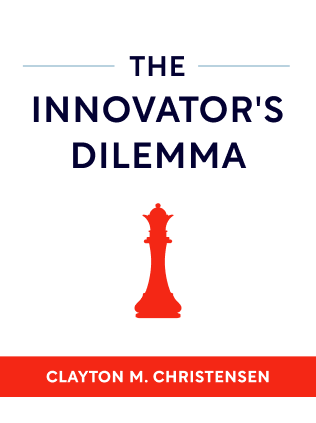

This article is an excerpt from the Shortform summary of "The Innovator's Dilemma" by Clayton M. Christensen. Shortform has the world's best summaries of books you should be reading.
Like this article? Sign up for a free trial here .
What are disruptive innovations? How does disruptive innovation theory influence business strategy?
Disruptive innovation theory is a concept that explains how the emergence of new, groundbreaking technologies can shake up entire industries. Even the big, established companies can be taken down by disruptive innovations.
So, what are disruptive innovations? Read on to learn more about disruptive innovation theory and its implications.
What Are Disruptive Innovations?
Innovations have the potential to upend industries. These kinds of significant innovations—called disruptive innovations—don’t come along very often, but when they do, they change how companies make and market products, the types of customers who buy them, and how they use them.
When disruptive technologies emerge, dominant, well-run companies often stumble. Business strategies that help companies succeed under normal circumstances—such as listening to what customers want and pursuing projects that promise high returns—have the opposite effect in the face of disruptive innovations. This is the innovator’s dilemma: The approaches that lead to success in adopting most innovations lead to failure when confronting disruptive innovations.
We’ll look at how and why successful, well-managed companies fail when faced with disruptive technologies, and how they can avoid those roadblocks.
There’s no way to get around the uncertainty of innovation, but you can reduce the uncertainty by understanding the traits of disruptive innovations, effective strategies for adopting them, and how to tell the difference between a disruptive and non-disruptive innovation.
Disruptive Innovation Theory, In Brief
What are disruptive innovations and how do they impact markets? A disruptive innovation represents a dramatically new way of doing things. After it matures, it will have revolutionized an industry and displaced the existing market leaders.
However, at the very beginning, the disruptive innovation looks like a toy, too simple or underpowered for use by the industry’s main customers. It appeals only to a small niche in a small market, and so incumbent companies don’t see it as a big enough opportunity to pursue. What are disruptive innovations’ origins? They usually come from upstarts who aren’t bound by the same requirements for large profits as incumbents.
However, what the incumbent companies don’t realize is that, over time, the disruptive product iteratively improves to be more and more capable. Eventually, it catches up to the existing product and does a good enough job, and often much more cheaply as well. Soon, the innovative product even leapfrogs the existing product, which has plateaued in its improvements due to limitations in its technology.
Because it’s now better and cheaper, the disruptive innovation is increasingly adopted by the industry. What looked like a toy for a niche market is now a massive business. By this time, the incumbent companies have taken notice, but they’re too far behind to catch up. The small upstart becomes a large company and displaces the incumbents. The incumbent may have done everything “right” in terms of standard business management, but they are still made obsolete by the radical innovation they ignored at first.
This pattern has played out time and time again in history, from automobiles replacing horses and railways, personal computers replacing mainframe computers, and the Internet revolutionizing retail, media, advertising, and nearly every other industry on the planet.
The book explains this disruption in more detail, why incumbent companies are so poorly equipped to produce disruptive innovations, and how they can cope with such disruption.
Customers Discourage Disruptive Products
What are disruptive innovations and do customers like them? Typically, companies succeed by giving customers what they want—if you keep your customers happy, your profits should stay high. But, as we’ll see, disruptive innovations don’t initially appeal to a company’s current customers.
Simple or complex, technological innovations fall into two categories: disruptive and sustaining.
By definition, established companies’ customers are always more interested in sustaining innovations, which simply improve upon the performance of the industry’s existing products. Because established companies are already dominant at developing and marketing existing products, they almost always lead their industries in successfully adopting sustaining innovations. Sustaining innovations constitute the majority of technological advancements in any industry.
By contrast, disruptive innovations disrupt the performance improvement trajectory of an industry’s existing products. Disruptive technologies don’t appeal to existing customers—instead, they open up an entirely new market. Entrant firms—or startups—almost always become the dominant forces in producing and selling disruptive products.
Customers’ disinterest in disruptive technologies discourages established companies from investing in developing the disruptive products, which leads to the companies’ eventual downfalls. Those companies that fail to adopt the disruptive technologies get the rug pulled out from under them later, when they discover that the disruptive products are taking over their market because the technologies have improved enough to satisfy their customers.
Case Study: What Are Disruptive Innovations in the Disk Drive Industry?
The disk drive industry faced disruptions on several occasions when disk drives shrunk. Each time, dominant companies failed because they listened to their customers and chose not to adopt the disruptive technologies.
In the 1970s, high-capacity 14-inch disk drives were the standard for the large mainframe computers that businesses used for large data processing. Then entrant firms introduced the 8-inch disk drive. The 8-inch drive didn’t have enough capacity for mainframes, but its lower total price and smaller size attracted manufacturers in the emerging market of minicomputers, which were mid-sized servers for businesses and databases.
Over time, the 8-inch drive makers improved capacity enough to satisfy mainframe makers. The price of the 8-inch drive also dropped even lower, and soon 8-inch drives took over the mainframe market.
Most 14-inch drive manufacturers never produced 8-inch drives, because their customers—mainframe computer makers—didn’t want the smaller drives with insufficient capacity. By the time 8-inch drives improved enough to meet mainframe makers’ needs, a minority of 14-inch drive manufacturers introduced 8-inch products, but they couldn’t compete with the startups. (We’ll explain why in the coming sections.) Eventually, every 14-inch drive maker failed.
This pattern repeated a few more times:
- The disruptive 5.25-inch drive attracted the emerging market of personal desktop computer (PC) makers, and eventually took over the minicomputer market.
- The disruptive 3.5-inch drive attracted the emerging market of laptop makers, and eventually took over the PC market.
Value Networks
A major factor determining whether a company adapts to disruptive technologies is whether its customers are interested in the new technology.
The theory of value networks explains how customer input is part of a larger system that determines how companies respond to customer input, set and pursue goals, and react to industry changes, such as disruptive innovations.
Just about every product requires specific component parts—for example, a mainframe computer needs circuit boards, a central processing unit, and disk drives—and each component part requires its own component parts. These parts are usually sourced from suppliers and manufacturers, creating a network of producers and markets.
Each nested network represents a unique value network, because the chain of supply and the products being manufactured determine each component’s value, based on two metrics:
- Performance attributes: These are the traits that customers value in a product—for example, small size and durability for laptops.
- Cost structures: These are determined by a product’s overhead costs, production volume, and price point, and they dictate the gross profit margins manufacturers need to cover costs.
A company’s value network provides the context for the organization’s decisions and actions, including how it approaches innovations. If an innovation affects a product’s attributes or cost in a way that is highly valued within the value network, then the company is more inclined to pursue it.
What are disruptive innovations and are they able to secure resources? This framework illustrates why established firms are reluctant to allocate limited resources—including time, money, and personnel—to these innovations, which have low value in both metrics:
- At first, disruptive innovations don’t have attributes that appeal to existing customers.
- Disruptive innovations seem to provide only low profits because they are initially marketable only to small, emerging markets.

———End of Preview———
Like what you just read? Read the rest of the world's best summary of Clayton M. Christensen's "The Innovator's Dilemma" at Shortform .
Here's what you'll find in our full The Innovator's Dilemma summary :
- Christensen's famous theory of disruptive innovation
- Why incumbent companies often ignore the disruptive threat, then move too slowly once the threat becomes obvious
- How you can disrupt entire industries yourself






